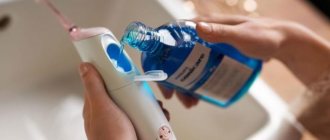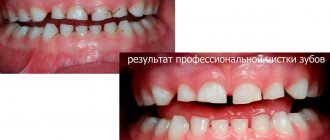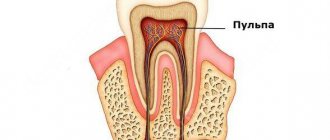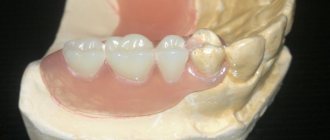Now many people are thinking about teeth whitening, and they can be perfectly understood: a beautiful smile will highlight any image and make a person more presentable. But it happens that a person has several artificial crowns and thinks about whitening tooth enamel. Then the dentist is asked the question: “Is it possible to whiten metal-ceramic crowns?” The only possible answer is: no! This is due to the fact that bleaching agents only affect natural enamel. Such products cannot lighten orthopedic structures.
If you plan to install crowns, then whitening should be done before prosthetics. When the enamel becomes lighter, you can begin installing orthopedic structures. Then the smile will be evenly snow-white, since the orthopedist will select the color of the ceramic coating to match his own enamel. Is it possible to whiten metal-ceramic crowns after they are installed? Answer: no! Here you can either accept it or completely change the design, which will require large financial investments.
Metal-ceramic crown
Modern materials used to make crowns are extremely durable and resistant to dyes. They are quite smooth and non-porous, so pigments cannot penetrate their structure. This is what allows you to limit yourself to daily oral hygiene using a toothbrush and regular paste.
If the material does darken, it is unlikely to be bleached. Metal-ceramics is a very hard and dense material in its structure; none of the modern brightening agents is able to penetrate inside it. In this case, it is possible to talk only about slight lightening, but not about whitening by several tones.
If the crowns are located on the side of the chewing teeth, then nothing will hinder the whitening of the smile area. Moreover, even a strong difference in shades will not affect the patient’s appearance in any way, because others simply will not notice it.
Teeth whitening with crowns are the 2 easiest options.
There are two seemingly options you can consider if whitening your natural teeth is a real concern due to the presence of crowns or veneers.
- If the number of crowns is small, for example, on 2-3 front teeth, you can always evaluate the color of the teeth again and redo the crowns in accordance with the new light color of natural teeth. In this case, you should wait 2-4 weeks after whitening for your teeth to acquire a new lighter natural color.
- Switching to dental veneering – this method eliminates the constant need to whiten natural teeth. This method may be an ideal solution when the “neighborhood” of natural and cosmetic teeth does not allow the whitening procedure. The dental veneering procedure allows you to “whiten” your teeth forever and have the desired snow-white smile without the risk of yellowing.
The best method that's right for you should be discussed with your dentist, as they will know best how your teeth may respond to whitening with crowns or veneers. The dentist will suggest which solution will be the most profitable and long-term in order to achieve the cosmetic aesthetics of your smile.
Ultrasonic cleaning of the oral cavity and results
You can lighten artificial dentures a little and restore the attractiveness of your smile with the help of professional cleaning. The whole point of this method is to eliminate plaque, tartar, food particles and deposits that have accumulated on the surface. Currently, specialists use a variety of methods for processing enamel; ultrasonic scalers are in great demand.
This method involves the use of a special device through the tip of which ultrasound and microvibrations are applied. They are capable of destroying even the hardest plaque in just a few seconds without much effort. Simultaneously with ultrasound, the device delivers a stream of water, due to which the enamel is protected from overheating, and crushed particles of contaminants are washed out from its surface.
Dental clinic specialists strongly recommend cleaning your mouth at least once every six months; this will protect the enamel from the accumulation of hard stone and preserve the health of your teeth for a long time. However, this procedure is also ineffective in whitening fillings and crowns.
What happens if there is no care
The manufacture and installation of a structure often makes a person feel as if it will remain unchanged for many years until it becomes unusable. The illusion that artificial materials do not need any special care, because they are not afraid of caries or periodontal disease, makes you relax and forget about the rules.
However, it is important to consider that all the substances from which prostheses are made also have their own characteristics, for example, a porous surface. This is where contaminants get clogged, which are then very difficult to get out. For example, a stone is almost impossible to remove with any folk remedies. When there is too much dirt, the following happens:
- Microbes and bacteria begin to penetrate the esophagus and stomach, causing all the beneficial substances to be absorbed worse, and the immune defense drops, and inflammatory processes develop.
- The cariogenic environment encourages and significantly accelerates the destruction of supporting teeth, if present.
- Stomatitis and similar diseases develop due to the action of colonies of microorganisms directly on the oral mucosa.
- The risk of breakage increases due to stone build-up and changes in the correct balance.
And the aesthetic indicators of a smile are extremely important for almost any person. Therefore, it is necessary to figure out how to clean removable dentures from plaque and blackness at home.
Installation of veneers and lumineers
As mentioned earlier, ceramic and plastic crowns are practically not amenable to any of the modern methods of whitening; they can only be cleaned of dirt accumulated on the surface. That is why many patients prefer using more advanced methods of dental restoration, for example, installing veneers.
Veneers are invisible overlays on the frontal area of the teeth, which are fixed using a special dental glue. With their help, you can easily disguise small chips, cracks, darkening of the enamel, as well as slight curvature and even gaps between teeth. These linings are made from very durable and resistant to external influences materials.
An even more reliable and aesthetically attractive option is lumineers. These are exactly the same pads, but thinner. Thanks to this, pre-grinding of the units is not required. Each of these prosthetic options involves taking impressions of the jaw, on the basis of which the onlays themselves are subsequently made. Quite often, doctors prefer to install veneers directly, that is, using a composite material and directly in the patient’s mouth.
Alternative remedies
In addition to pharmacological, technical and professional methods of cleaning and whitening dentures, there are a number of folk methods that are preferred due to their accessibility and simplicity. The following substances are used for cleaning.
| Substance, means | Description |
| Sodium bicarbonate (soda) | The denture is cleaned with a toothbrush, onto which a soda paste has previously been applied (acts as an antiseptic and abrasive). Sedum cleaning with soda is preferable for removable structures, since the pressure and intensity of the cleaning process are easier to control. Cleaning fixed structures is fraught with irritation of the oral mucosa and bleeding from the gums. Frequency of application: once every ten days. |
| Sodium chloride (salt) | Abrasive material. The cleaning technique is similar to the previous method. Salt is applied to a damp toothbrush. Finely ground table salt is selected to reduce the abrasive effect. Because the plastic wears less, the acceptable frequency of use increases to once every five days. |
| Lemon juice | Organic acids in citrus fruits corrode the dyes in food and drinks, which contribute to the darkening of dentures. The content of corrosive acids in the pulp is higher than in the peel. A mixture of lemon juice and salt is used to rinse the oral cavity twice a week. More frequent use is fraught with the aggressive effect of citric acid on the prosthesis material and on the oral cavity itself. |
| Hydrogen peroxide | The use of this substance is based on the content of active oxygen in the composition. The permissible concentration of peroxide is 3%. Method of application: rubbing with a cotton swab into the denture. Frequency of procedure: twice a month. |
| Banana peel | The advantage of banana peels over citrus fruits is their lower content of citric acids, so treating the prosthesis with this method can be done relatively more often: daily. Directions for use: the oral cavity is cleaned with a toothbrush and classic hygiene products, and rinsed with water. The denture is rubbed with the inside of the peel. The banana residue is left for ten minutes and washed off. The effect should be expected after about seven days. |
| Vinegar solution | The removable structure is placed in the solution for two hours. Frequent use of this method can lead to damage to the prosthesis. |
When choosing any of the above products, you should take into account the type of structure and the material from which it is made. Folk remedies prevent the penetration of infections and are more suitable for preventive measures than for directly cleaning darkened areas of dentures. It should be noted that the main cause of blackened areas is inadequate cleaning, so compliance with the necessary hygiene measures applicable to the oral cavity is the most important preventive method.
Important ! The service life of the prosthesis increases significantly with proper care.
It is better to include folk remedies as additional cleansing measures. If the dental structure darkens, it is wiser to consult a dentist, especially if the darkening of the denture is accompanied by other local symptoms.
Prevention
To ensure that fillings and crowns do not change their color or lose their attractiveness over time, it is very important to properly care for them. Care involves daily oral hygiene (morning, evening, and after each meal). It is also very important to remember to visit your dentist regularly for checkups.
In addition to the timely detection of enamel and gum diseases, the doctor can carry out preventive cleaning. If a patient has a bridge installed in their mouth, they should rinse the area between the crown and the gum tissue as often as possible. In this case, you can use a device such as an irrigator.
Other recommendations include abstaining from eating solid and coloring foods, strong coffee and black tea, red wine, quitting smoking and other bad habits. It is important to avoid strong temperature changes, as this can lead to loosening of the material and its darkening in the future.
previous post
Is it possible to treat teeth with stomatitis?
next entry
Reasons for darkening of dentures
The main reason for the darkening of dentures is non-compliance with the rules of care for dental structures. Constant and prolonged exposure to saliva, food particles and drinks contributes to the blackening of dentures before the prescribed service life.
The material used in dentistry is porous. Dyes leave a residue over time, even with thorough cleaning, so the prosthesis should be replaced at least once every three to five years. Otherwise, the structure becomes fragile and can damage your gums and teeth.
The rate of blackening depends on the material of the prosthesis and the acidity of the patient’s gastrointestinal tract. Separately, it should be noted the phenomenon of galvanism of metal structures. Metal is a good conductor, and saliva is an electrolyte. When a conductor comes into contact with an electrolyte, an electric charge occurs. This phenomenon in dental prosthetics is possible when metal prostheses are used, when metal amalgams are used to fill carious teeth, and the pH composition of saliva (normally the reaction is neutral) becomes acidic or alkaline (for example, due to inflammatory processes in the oral cavity). This can also occur with gastrointestinal pathologies. In this case, the darkening of gold and stainless steel crowns will be accompanied by dry mouth, increased salivation, an uncharacteristic taste, glossalgia (pain in the tongue area without macroscopic changes) and other symptoms associated with allergic, chemical-toxic and electrogalvanic reactions.
Important ! In case of galvanism, it is necessary to immediately consult a dentist and change the prosthesis to a structure made of a non-metallic material.
Basic rules for storing removable systems
Most modern removable dentures are stored directly in the mouth. For example, in principle, it is not necessary to remove clasp, Quattro Ti (“Quadrotti”), sandwich dentures at night and even every day - by the way, that’s why they are often called conditionally removable. Full or partial removable ones made of acrylic, nylon or Acry-free (“Acry-free”) can also be left in place at night. But any orthopedic structure needs to be cleaned at least 2 times a day! A well-cleaned product is dried with a paper or cloth towel and, if necessary, stored in a container. It is advisable to purchase a special one, which can also be used as a cleansing bath.
Read more about how to store dentures correctly so that they last as long as possible and maintain an attractive appearance.
Review of the best ways to whiten and clean dentures – at home and in the dental clinic
Article navigation
- Why do you need care?
- What happens if there is no care
- Basic storage rules
- Cleaning methods
- Cleansing and whitening at home
- - Toothbrush
- – special pastes and gels
- - tablets and solutions
- - ultrasonic bath
- Professional cleansing in the clinic
- Is it worth using folk remedies?
- - citrus juices and citric acid
- - baking soda and hydrogen peroxide
- Side effects due to inappropriate medications
- How to maintain the aesthetics of your smile
- User Questions
Question to a specialist
Dentures are placed in order to restore the aesthetics and chewing function of the dental system. But active or improper use of orthopedic structures can lead to the appearance of stains and plaque on them. Can dentures be whitened? Cleaning artificial “jaws” – plastic, acrylic, etc. – to their original appearance is quite problematic, but possible. Next, we will tell you how to clean them from tartar, blackness and yellowness, pigmentation, and what is better to use - folk remedies at home or still turn to professionals in dentistry.











